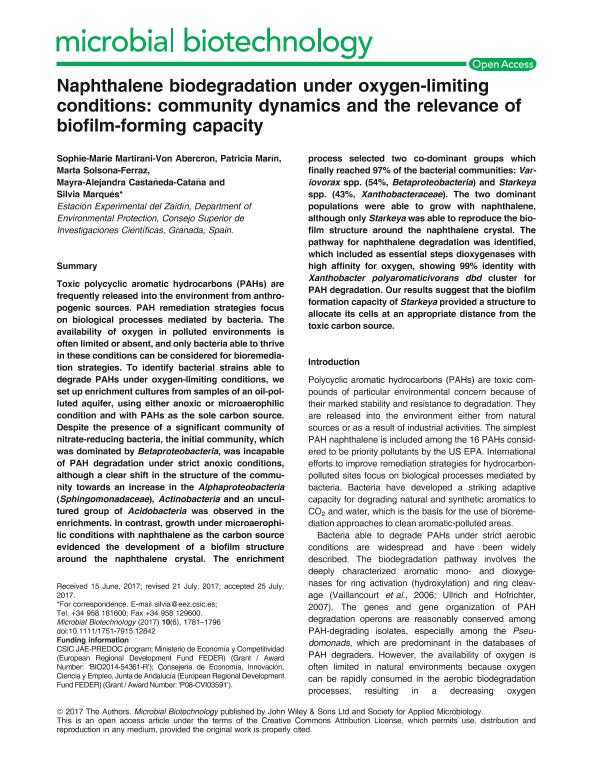Artículo
Naphthalene biodegradation under oxygen-limiting conditions: community dynamics and the relevance of biofilm-forming capacity
Martirani Von Abercron, Sophie Marie; Marín, Patricia; Solsona Ferraz, Marta; Castañeda Cataña, Mayra Alejandra ; Marqués, Silvia
; Marqués, Silvia
 ; Marqués, Silvia
; Marqués, Silvia
Fecha de publicación:
08/2017
Editorial:
John Wiley & Sons Ltd
Revista:
Microbial Biotechnology
ISSN:
1751-7915
Idioma:
Inglés
Tipo de recurso:
Artículo publicado
Clasificación temática:
Resumen
Toxic polycyclic aromatic hydrocarbons (PAHs) are frequently released into the environment from anthropogenic sources. PAH remediation strategies focus on biological processes mediated by bacteria. The availability of oxygen in polluted environments is often limited or absent, and only bacteria able to thrive in these conditions can be considered for bioremediation strategies. To identify bacterial strains able to degrade PAHs under oxygen-limiting conditions, we set up enrichment cultures from samples of an oil-polluted aquifer, using either anoxic or microaerophilic condition and with PAHs as the sole carbon source. Despite the presence of a significant community of nitrate-reducing bacteria, the initial community, which was dominated by Betaproteobacteria, was incapable of PAH degradation under strict anoxic conditions, although a clear shift in the structure of the community towards an increase in the Alphaproteobacteria (Sphingomonadaceae), Actinobacteria and an uncultured group of Acidobacteria was observed in the enrichments. In contrast, growth under microaerophilic conditions with naphthalene as the carbon source evidenced the development of a biofilm structure around the naphthalene crystal. The enrichment process selected two co-dominant groups which finally reached 97% of the bacterial communities: Variovorax spp. (54%, Betaproteobacteria) and Starkeya spp. (43%, Xanthobacteraceae). The two dominant populations were able to grow with naphthalene, although only Starkeya was able to reproduce the biofilm structure around the naphthalene crystal. The pathway for naphthalene degradation was identified, which included as essential steps dioxygenases with high affinity for oxygen, showing 99% identity with Xanthobacter polyaromaticivorans dbd cluster for PAH degradation. Our results suggest that the biofilm formation capacity of Starkeya provided a structure to allocate its cells at an appropriate distance from the toxic carbon source.
Archivos asociados
Licencia
Identificadores
Colecciones
Articulos(IQUIBICEN)
Articulos de INSTITUTO DE QUIMICA BIOLOGICA DE LA FACULTAD DE CS. EXACTAS Y NATURALES
Articulos de INSTITUTO DE QUIMICA BIOLOGICA DE LA FACULTAD DE CS. EXACTAS Y NATURALES
Citación
Martirani Von Abercron, Sophie Marie; Marín, Patricia; Solsona Ferraz, Marta; Castañeda Cataña, Mayra Alejandra; Marqués, Silvia; Naphthalene biodegradation under oxygen-limiting conditions: community dynamics and the relevance of biofilm-forming capacity; John Wiley & Sons Ltd; Microbial Biotechnology; 10; 6; 8-2017; 1781-1796
Compartir
Altmétricas



